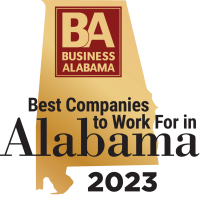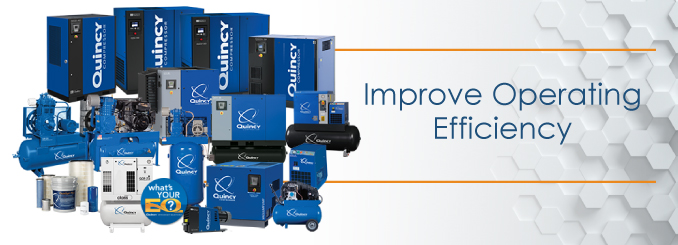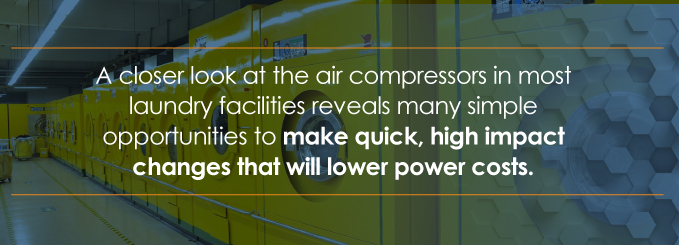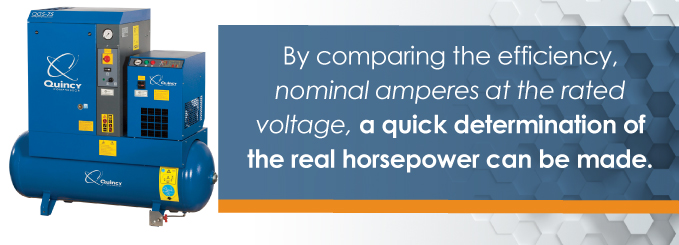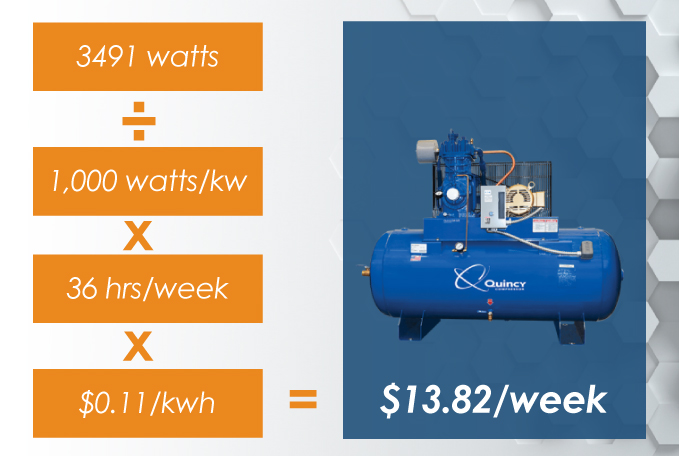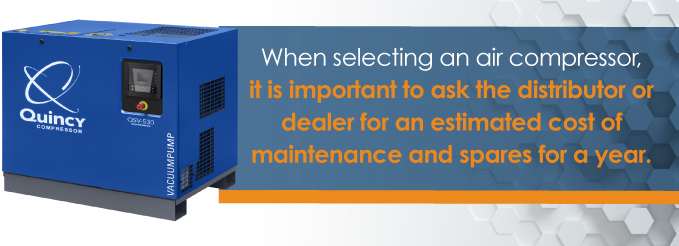How can I improve my operating costs?
Can operating a profitable company also be environmentally friendly? For most companies, the idea of protecting the environment and conserving natural resources brings to mind expensive renovations and higher operating cost. One way to help the environment and lower operating costs at the same time is to take a look at the air compressor that powers much of the equipment in the shop. Chances are good that savings are waiting just around the corner to be discovered.
Compressed air is used throughout many modern laundering facilities, and goes unnoticed until there is a problem. A closer look at the air compressors in most laundry facilities reveals many simple opportunities to make quick, high impact changes that will lower power costs and keep air-powered equipment operating reliably. A systematic approach helps uncover the best steps to take based on the current situation. Start by understanding the true cost of compressed air – it really is not free!
Contact Us Learn More Find a Dealer Near You
Opportunity Number One: Determine Real Horsepower
Why?
Electrical equipment requires energy to operate, and energy costs money. How much energy is directly related to the work the equipment does, or in this case, the horsepower of the air compressors. By making a fair comparison of real horsepower, it is easy to estimate the amount of energy required and the associated power cost.
Depending on the size of the operation, top-performing laundering facilities require a compressor between 5 and 15 horsepower. Air compressor manufacturers rate their equipment based on both the horsepower and air capacity (cfm or l/min). To get an idea of the actual cost to operate an air compressor, users are left to interpret the horsepower rating of each compressor model.
For instance, why does one five horsepower compressor cost about a third as much as another? A close examination of the motor nameplate and air capacity of each quickly reveals that the two compressors are not really alike. To obtain the real cost of operation, examining the motor nameplate is a good place to start. The nameplate will reveal the voltage, operating amperes, nominal efficiency and power factor and the service factor of the motor. By comparing the efficiency, nominal amperes at the rated voltage, a quick determination of the real horsepower can be made:
Rated Horsepower – 5 Volts – 230 Amperes – 13.8
NEMA Efficiency – 87.5 Service Factor – 1.15
A simple equation (power law equation) can be applied as follows:
Power (watts) = Volts x Amps -or- Power = (230 Volts x 13.8 Amps)
Which yields 3174 watts…what? Therefore, if each horsepower is equal to 746 watts, we have a motor with a nominal nameplate rating of (3174 watts x 1 hp/746 watts), or 4.25 hp. That’s unexpected. The nameplate provides other information, like efficiency and service factor. To understand how much real electricity is required to make the nominal rating, take the calculated power and divide this value by the NEMA Efficiency value (a percentage value):
(3174 watts / 0.875) = 3627 watts of electricity, or 4.86 horsepower…still not what is expected.
Air compressor manufacturers will use what is called the service factor of the electric motor to provide extra power to the air compressor and compensate for pressure drop, wear and high-temperature operation. The service factor is a designed-in overload factor that allows the motor to operate above the nominal nameplate rating.
Some motors are rated as continuous duty and can perform normally in the service factor. It is important to note this on the motor nameplate, as it explains how some air compressors are rated (intermittent versus continuous). The nameplate on the example motor shows a service factor of 1.15. Air compressor manufacturers will typically use 7-10% (1.07 – 1.10) of the overload capacity of the motor to generate extra power and keep the balance (5-8%) in reserve for high-temperature operation.
OK, the cost of operation is based on the number of watts consumed over a period of time. The above formula yielded 3174 watts. Considering the normal amount of service factor the compressor is likely to use, the total power consumed will be 3147 watts x 1.10, or 3491 watts. Since power is paid for in kwh, or kilowatt hours, it is necessary to convert the watts to kilowatts (divide by 1000) and apply the normal operating time expected for the compressor. For example, if the air compressor were to operate 36 hours a week and power cost from a recent utility bill is stated at $0.11/kwh, the approximate cost per week would be:
This may seem like a lot of work to go through to decide which compressor will cost less to power, but over the life of a normal air compressor, the power cost savings from a wise selection will more than pay for the original difference, if not the entire cost of the air compressor. In addition, by using less energy, companies that spend a few extra minutes considering efficiency are helping reduce the amount of power consumed nationally, which in turn protects our environment.
Opportunity Number Two: Determine Maintenance Investment
Why?
All mechanical equipment requires maintenance, whether it is a steam press, drum washer or an air compressor. Saving a few dollars on the initial investment can sometimes haunt a company when the bargain equipment is constantly being worked and repaired. Like the investment in a high efficiency piece of equipment, selecting a reliable air compressor will be a decision that could save money for decades.
When selecting an air compressor, or any piece of equipment, it is important to ask the distributor or dealer for an estimated cost of maintenance and spares for a year. By asking the supplier to provide the list of spares and their estimated costs, there is no doubt about the requirements for complying with manufacturer’s warranty and a fair comparison can be made among different brands. Some important information to gather includes:
- Standard warranty period
- Extended warranty availability (and cost)
- Requirements to keep the warranty valid
- Authorized service center locations
- Special or unique parts requirements (like filters or synthetic oil)
- Maintenance intervals (in operating hours)
- Recommended rebuild/overhaul interval
- Special handling or disposal requirements for waste filters and oil
Depending on the type of air compressor that is appropriate to meet capacity requirements, either a reciprocating (piston) or rotary screw type compressor might be selected. Additionally, lubricated or oil-free (oil-less) compressors might be required. Each compressor type will require maintenance, and the oil-free (oil-less) compressors are a bit more complex than their lubricated counterparts. While maintenance will not have the impact on cost of ownership that power does over the life of the air compressor, it can become quite costly if not attended to per manufacturer’s recommendations.
Typically, manufacturers will offer different levels of equipment based on value and design. A less expensive air compressor will have the same basic technology as its more expensive cousin, but will not have the same quality valves, motor, oil, or other basic components. This helps keep the first cost low. The trade-off is often lower efficiency and shorter life.
It is not uncommon for five horsepower air compressor pricing to range from less than $750 to near $2000. The difference can be measured in compressor life, sometimes as short as 2000 hours versus 40 years for a heavy duty pressure lubricated compressor. While the upfront cost is attractive, it would seem the maintenance would involve throwing away the lesser air compressor every year or so and replacing it with a new machine. Even if it were planned to keep the air compressor and perform a rebuild, it may not be possible with less costly air compressors.
The consumption of special parts and oil also must be considered in the cost of ownership. It is typical for manufacturers of rotary screw air compressors to provide a long-life synthetic fluid to enhance the performance of the air compressor. Synthetic oils will last from 4000 hours to an indefinite period before requiring a change-out.
Depending on the type of fluid used, special handling and disposal might be required. For example, normal motor oil, which is rarely used in any type of air compressor, can be easily discarded without being considered a hazardous waste. Automatic transmission fluid, which will last about twice as long and reflects that in its price, can similarly be disposed of fairly simply. Both types of fluid are collected routinely by oil recyclers to be re-blended.
Synthetic fluids and blends, however, sometimes require special handling for proper disposal. Ester and olefin type fluids must be identified and require special disposal in some municipalities. It is best to check before buying to ensure all costs are factored.
Other types of fluid are considered to be biodegradable, and thus suitable for disposal in a sewer system. Such fluids, polyalkeneglycol or polyglycol, should have a certificate from the manufacturer that states the fluid’s biodegradability.
Other specialty chemicals like silicon blends or pure silicon represent another disposal issue and should be disclosed prior to purchase. Note that the more features a fluid has, like long life and high temperature stability, the more expensive it will be to buy and discard.
By carefully selecting an air compressor that has a balance between long service life and parts cost, it is possible to save even more money over the life of the equipment. Also, by weighing the maintenance requirements, the impact of waste filters and fluid can be managed as well. Less cost and less waste is better for the economy and ultimately is better for the environment.
Opportunity Number Three: Uncover Hidden Costs
Why?
Every mechanical system changes with age. Corrosion, changes in demand and tired equipment can cause a system that was once state of the art to be a secret energy vampire. New pieces of equipment are added that require more air, more piping is added, scale forms inside pipes and joints, drains stop working…the list can be overwhelming. A fresh look at any air system can usually identify actions that will save energy and improve air quality.
For a cursory overview or an in-depth system audit, companies like Quincy Compressor offer best practice solutions, as well as self-audit tools and full engineering audits. Fully trained compressed air systems experts can easily help optimize nearly any system, no matter how large or small.
Some areas to consider when deciding if a system audit would help include: the air compressor itself and its duty cycle, the compressed air treatment devices like filters and air dryer, proper compressed air storage, piping and condensate removal equipment. This list represents pretty much the entire air system, and each section has potential to either rob energy or provide savings, depending on how it is treated.
Whether you enlist the help of a professional or use a simple self-auditing tool like the Quincy Compressor EQ worksheet, the benefits will be felt immediately and for as long as the best practice advice is followed. Simple advice and guidance in the operation and maintenance of your compressed air system will make your operation more efficient, profitable and friendly to the environment.
Being efficient helps keep your profits, as well as the planet, in the green. Make sure you know how the business partners you select will impact your efforts. Seemingly simple choices can have the greatest and long-lasting impact on the future.

